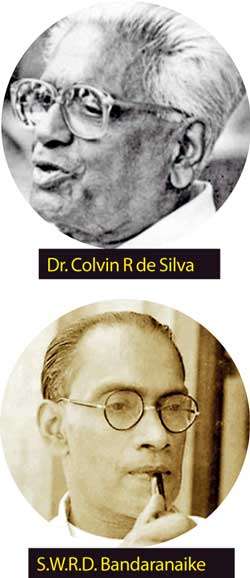Reply To:
Name - Reply Comment
 Today is the forgotten Republic Day. Sri Lanka became a Republic on 22nd May 1972, with the adoption of a new Constitution. Until the war victory on 18th May 2009, which overshadowed it, every year on May 22 All Ministries, Government Departments, Statutory Corporations and other State institutions commemorated Republic Day. Heads of the department with the participation of staff hoisted the national flag and delivered a short speech on the importance of this Day. I remember the then Ministry of Constitutional Affairs and National Integration distributed brochures titled the ‘Birth of a Republic’ among school students explaining its significance; that the country achieved real independence from imperialists. The independence, the country achieved on 4th February, 1948 became meaningful through the Republic Constitution in 1972. Dr. Colvin R. De Silva played a prominent role in the compilation of this Constitution as the Minister of Constitutional Affairs in addition to his Plantations portfolio.
Today is the forgotten Republic Day. Sri Lanka became a Republic on 22nd May 1972, with the adoption of a new Constitution. Until the war victory on 18th May 2009, which overshadowed it, every year on May 22 All Ministries, Government Departments, Statutory Corporations and other State institutions commemorated Republic Day. Heads of the department with the participation of staff hoisted the national flag and delivered a short speech on the importance of this Day. I remember the then Ministry of Constitutional Affairs and National Integration distributed brochures titled the ‘Birth of a Republic’ among school students explaining its significance; that the country achieved real independence from imperialists. The independence, the country achieved on 4th February, 1948 became meaningful through the Republic Constitution in 1972. Dr. Colvin R. De Silva played a prominent role in the compilation of this Constitution as the Minister of Constitutional Affairs in addition to his Plantations portfolio.
However, long before this happened in 1956 former Prime Minister S.W.R.D. Bandaranaike set up a Parliamentary Select Committee to draft a new Constitution for the same purpose, but it did not materialize. The republican idea was mooted in 1970 by the leaders of the LSSP during the drawing up of a Common manifesto of the United Front for General Election, which said, ‘we seek a mandate to permit the members of Parliament you elect to function simultaneously as a constituent assembly to draft, adopt and operate a new constitution…which would declare Ceylon to be a free, sovereign and independent Republic pledged to realize the objectives of Socialist Democracy’. It was placed before the people for a mandate at May 27, 1970 elections. The 1972 Constitution secured fundamental rights and freedoms to all citizens, a feature lacked in the Soulbury Constitution.
The Coalition Government of the Sri Lanka Freedom Party, the Samasamajists and the Communists, led by Sirimavo Bandaranaike set up a ‘Constituent Assembly’ on July 21, 1970, to draft a new Republican constitution which was adopted by the Constituent Assembly on the 22nd of May, 1972. The Soulbury Constitution, drafted by Sir Ivor Jennings, which the British Colonial government had imposed on us in 1947 before conceding independence, ceased to have effect from this date. May 22, 1972 became a historic day for Sri Lanka when the final link of the chain that bound us to the British imperialists was severed and the totally independent Republic of Sri Lanka was born. The Republican Constitution was a significant achievement ending the two and a half millennia of monarchical rule as per recorded history of the island nation. The position of Governor General was abolished and a ceremonial post of President was established. The new constitution marked the change in status of our land and its people. It has a foundation or root which is entirely different from the authority of British Crown over Ceylon.
The new constitution marked the change in status of our land and its people. It has a foundation or root which is entirely different from the authority of British Crown over Ceylon.
It is this Constitution that enabled us to remove the economic bonds that bound us to Britain and to expand our relations with the other nations. We were able to serve our own interests. We freed our nation from British economic and political authority. The British crown was no longer the crest of our Government. Britons lost direct control of the tea plantations through which the Sterling companies drew profits away to Britain. Tea auctions located in Britain were relocated in Colombo.
Dr. Colvin R de Silva, the leading criminal lawyer, historian and a leader of Marxist movement in the island, who once commented, “…that’s because God never trusted them in the dark” in response to famous saying that identified the British Empire as, ‘The Empire that sun never sets’, was appointed as the head of the drafting committee. He ensured maximum power to the Legislature through the elected representatives of the people, which powers the 1978 Constitution of Jayewardene brothers [JR and HW] took away and place it in the hands of a single individual, the Executive President, resulting in many problems of authority that confront us.
Removing Section 29 of the Soulbury Constitution
Two charges were levelled against the architect of the draft proposals, Dr. Colvin, by sections of minority, that by deleting Section 29 of the Soulbury Constitution, the protection that existed to the minorities has been removed.
Section 29 (2) says, ‘No law shall -prohibit or restrict the free exercise of any religion; or make persons of any community or religion liable to disabilities or restrictions to which persons of other communities or religions are not made liable; or confer on persons of any community or religion any privilege or advantage which is not conferred on persons of other communities or religions, or alter the constitution of any religious body except with the consent of the governing authority of that body, so, however, that in any case where a religious body is incorporated by law, no such alteration shall be made except at the request of the governing authority of that body.’
The 1972 Constitution being entirely new; the question of preserving a section of the old constitution does not arise. The introduction of a completely new chapter on Fundamental Rights, was something the Soulbury Constitution did not carry. Dr Colvin argued, “through a chapter on Fundamental Rights, we did what was done or supposed or believed to have been made by Section 29 of the Soulbury Constitution, together with things that were not done there.”
The Indian Tamil voters were disenfranchised by the D.S. Senanayake government by passing the Citizenship Bill of 1948:Section 29 of the Soulbury Constitution did not prevent the passing of the relevant bill: again, same with the Official Language Act of Bandaranaike in 1956; which made Sinhala only the official language. The 1972 constitution introduced a section compelling the Courts to scrutinize the bills before they were passed instead of after it is passed. The above two legislations would not have received the sanction of Courts if the 1972 Provisions were there.
Chapter VI -1972 Constitution- Fundamental Rights and Freedoms
 18. (1) ‘all persons are equal before the law and are entitled to equal protection of the law; no person shall be deprived of life, liberty or security of person except in accordance with the law; no citizen shall be arrested, held in custody, imprisoned or detained except in accordance with the law; every citizen shall have the right to freedom of thought, conscience and religion. This right shall include the freedom to have or to adopt a religion or belief of his choice, and the freedom, either individually or in community with others and in public or private, to manifest his religion or belief in worship, observance, practice and teaching; every citizen has the right by himself or in association with others, to enjoy and promote his own culture; all citizens have the right to freedom of peaceful assembly and of association; every citizen shall have the right to freedom of speech and expression, including publication; no citizen otherwise qualified for appointment in the central government, local government, public corporation services and the like, shall be discriminated against in respect of any such appointment on the ground of race, religion, caste or sex’
18. (1) ‘all persons are equal before the law and are entitled to equal protection of the law; no person shall be deprived of life, liberty or security of person except in accordance with the law; no citizen shall be arrested, held in custody, imprisoned or detained except in accordance with the law; every citizen shall have the right to freedom of thought, conscience and religion. This right shall include the freedom to have or to adopt a religion or belief of his choice, and the freedom, either individually or in community with others and in public or private, to manifest his religion or belief in worship, observance, practice and teaching; every citizen has the right by himself or in association with others, to enjoy and promote his own culture; all citizens have the right to freedom of peaceful assembly and of association; every citizen shall have the right to freedom of speech and expression, including publication; no citizen otherwise qualified for appointment in the central government, local government, public corporation services and the like, shall be discriminated against in respect of any such appointment on the ground of race, religion, caste or sex’
Foremost Place for Buddhism
The Kandyan Chiefs and the Mahanayake Theras agreed to the Kandyan Convention as Governor Brownrigg cunningly included an article,[the fifth clause] -
‘The religion of Buddha, professed by the chiefs and inhabitants of these provinces is declared inviolable and its rites and ministers and places of worship are to be maintained and protected’.
The 1948 Constitution of Independent Sri Lanka didn’t give ‘Buddhism the foremost place’ as of now. D.S. Senanayake was under pressure to include a special clause for Buddhism by the two prelates of Asgiriya and Malwatta who in protest threatened to boycott the Independence inauguration ceremony. At a conference with the Mahanayakes of the two chapters, Prime Minister D.S. did not give in but convinced the two Prelates on the importance of not introducing special provisions on protection or foremost place to Buddhism saying, “If equality is a basic tenet of Dhamma, then you can’t give primacy to one religion.” In 1972, PM Sirimavo being mindful of Article 5 of the 1815 Kandyan Convention, she had directed Dr. Colvin to provide the ‘foremost place’ to Buddhism. The Trotskyite could not escape inclination towards religion though he regretted it later. It was his republican constitution, which provided Buddhism a special place. From then onwards the bhikkhus became lasting players in Sri Lankan politics. From 1972, was there any special protection or progress to Buddhism by the Government; and what damage it did to Buddhism from 1948 to 1972, during which stage there was no such constitutional assurance?
Colvin had quipped
“she is thrusting the Kandyan Throne into our Constitution.”
Sirimavo’s government which initiated the conversion to a Republican Constitution; and Dr. Colvin, who was responsible for the draft as Minister of Constitutional Affairs in that government signified the completion of our political sovereignty. The leftists had always believed that the country’s dominion status could be transformed into real independence only with the separation of its constitutional attachment with Britain and the vesting of political autonomy in the people.
“Whenever any form of government becomes destructive of these ends [life, liberty, and the pursuit of happiness] it is the right of the people to alter or abolish it, and to institute new government.
”--Thomas Jefferson